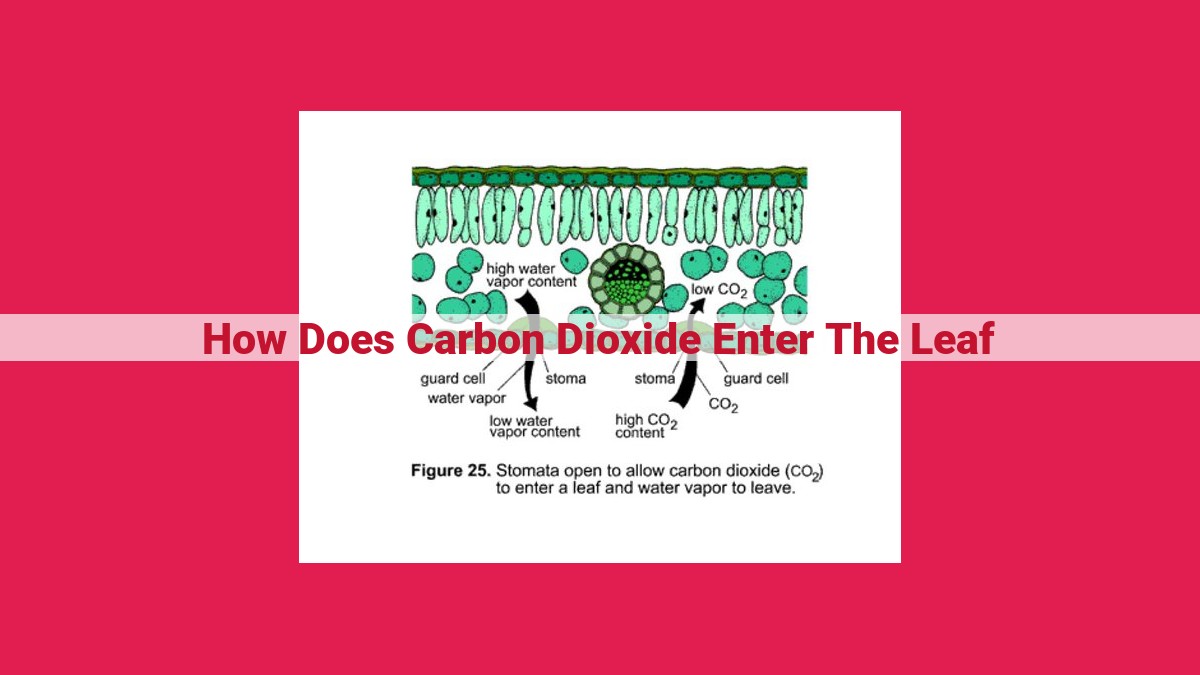Diffusion Of Carbon Dioxide Through Stomata In Leaves

- Diffusion through Stomata
Stomata are tiny pores on the leaf surface that allow carbon dioxide to enter. Transpiration, the evaporation of water from leaves, creates a negative pressure that keeps stomata open. Stomata have guard cells that control their opening and closing, regulating the amount of carbon dioxide entering the leaf.
Diffusion Through Stomata: The Gateway for Carbon Dioxide
Stomata, microscopic pores on the leaf’s surface, serve as the gatekeepers for carbon dioxide’s entry into the plant’s respiratory system. These minuscule apertures allow the vital gas to permeate the leaf’s interior, providing the building blocks for photosynthesis.
Transpiration, the evaporation of water from leaves, plays a crucial role in stomatal opening. As water vapor escapes, it creates a negative pressure, pulling water up through the plant from the roots. This pulling force also maintains the stomata’s patency, allowing carbon dioxide to freely enter.
The structure of stomata is intricately designed for optimal carbon dioxide uptake. Each stoma is composed of two guard cells, specialized cells that regulate the pore’s opening and closing. These guard cells are studded with chloroplasts, which harness sunlight to produce sugars through photosynthesis. When sugars accumulate in the guard cells, water enters them, increasing their turgor pressure and causing the stoma to open wider.
By controlling stomatal opening and closing, plants can balance carbon dioxide uptake with water loss. When carbon dioxide levels are low or water is scarce, stomata close to conserve precious moisture. Conversely, when conditions are favorable, stomata open wide, maximizing carbon dioxide intake and fueling the photosynthetic process.
Carbon Dioxide’s Journey into the Liquid Embrace
Plants, the lifeblood of our planet, rely on carbon dioxide as their sustenance. But how does this vital gas make its way into the plant’s interior? One crucial pathway is through dissolution in water.
Imagine carbon dioxide molecules as tiny explorers, eager to penetrate the leaf’s watery realm. As these molecules encounter the leaf’s surface, they encounter a thin layer of water. Like intrepid divers, they dissolve into this liquid environment, abandoning their gaseous form for a temporary aquatic adventure.
This process of dissolution creates a concentration gradient between the gaseous carbon dioxide outside the leaf and the dissolved carbon dioxide within. This gradient, like a siren’s call, attracts even more carbon dioxide molecules into the water, driving the dissolution process forward.
However, the dissolved carbon dioxide isn’t content with being trapped in the watery depths. It seeks to equilibrate with the gaseous carbon dioxide in the surrounding air. This delicate balance ensures a constant exchange of carbon dioxide, allowing plants to take up this essential nutrient while simultaneously releasing some back into the atmosphere.
The concentration of carbon dioxide in water is crucial for plant life. If the concentration is too low, plants will struggle to acquire sufficient carbon dioxide for photosynthesis, while excessive concentrations can lead to toxic levels. Remarkably, plants have evolved intricate mechanisms to maintain an optimal balance of dissolved carbon dioxide, ensuring their survival and ensuring our planet’s vibrant tapestry of life.
Active Transport: The Unsung Hero of Plant Carbon Dioxide Uptake
Plants, the very foundation of our planet’s life, require a steady supply of carbon dioxide to fuel their growth and survival. But how do these rooted beings acquire this vital gas from the vast expanse of the atmosphere? Enter active transport, a remarkable physiological process that defies the constraints of diffusion to ensure plants’ photosynthetic needs are met.
Unveiling Active Transport
Active transport challenges the natural tendency for molecules to move from high to low concentrations. Instead, it employs specialized proteins embedded in plant cell membranes to actively pump ions and molecules against their concentration gradient. This energy-intensive process requires metabolic energy, typically in the form of adenosine triphosphate (ATP).
In the context of carbon dioxide uptake, active transport plays a crucial role in transporting this gas into the mesophyll, the photosynthetic tissue of leaves. Here, carbon dioxide is immediately converted into bicarbonate ions, a form that is easily assimilated by the plant’s chloroplasts for use in photosynthesis.
Significance in Low-Carbon Dioxide Environments
Active transport becomes particularly important for plants that thrive in low-carbon dioxide environments. These environments, such as arid deserts or the depths of oceans, pose a significant challenge for plants to acquire the carbon they need for growth.
In such conditions, active transport provides a distinct advantage by enabling plants to actively concentrate carbon dioxide from the surrounding environment, effectively enhancing their ability to photosynthesize and sustain their existence.
Closing Note
Active transport is a remarkable adaptation that allows plants to overcome the limitations of diffusion and secure the carbon dioxide they need to thrive. This process, often overlooked but indispensable, plays a vital role in the intricate dance of life on our planet.